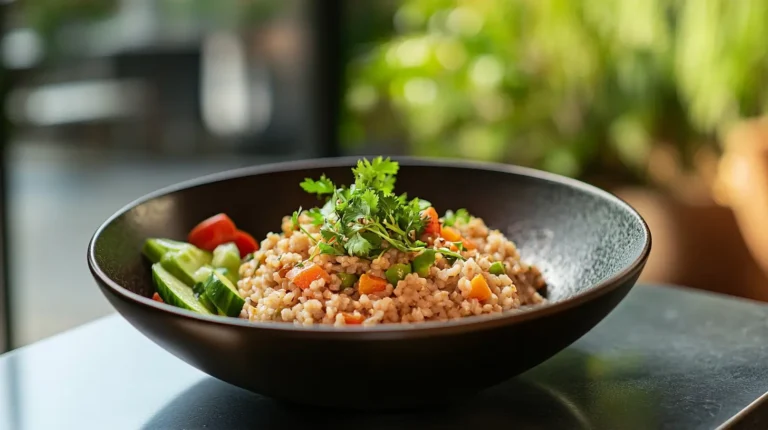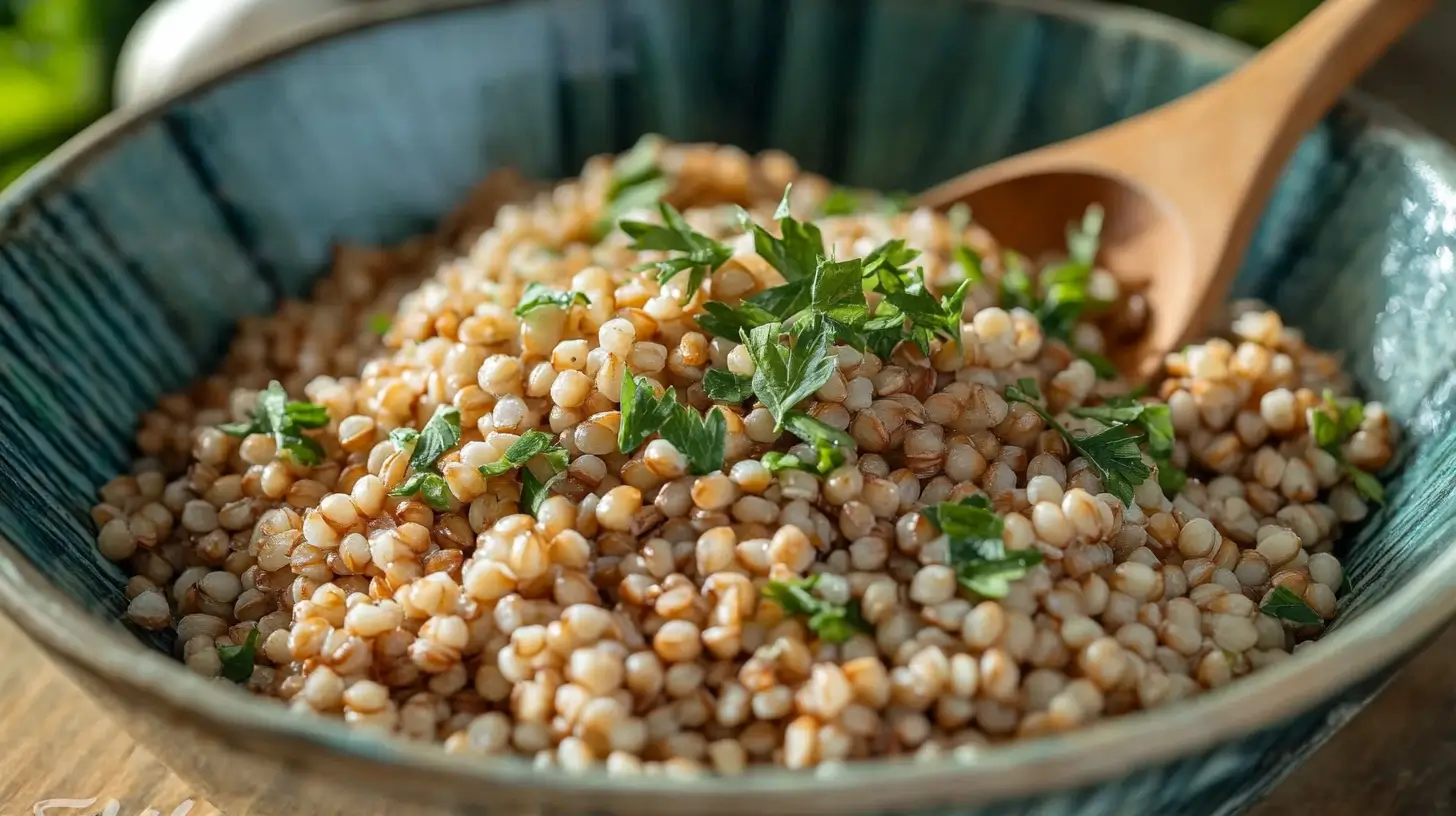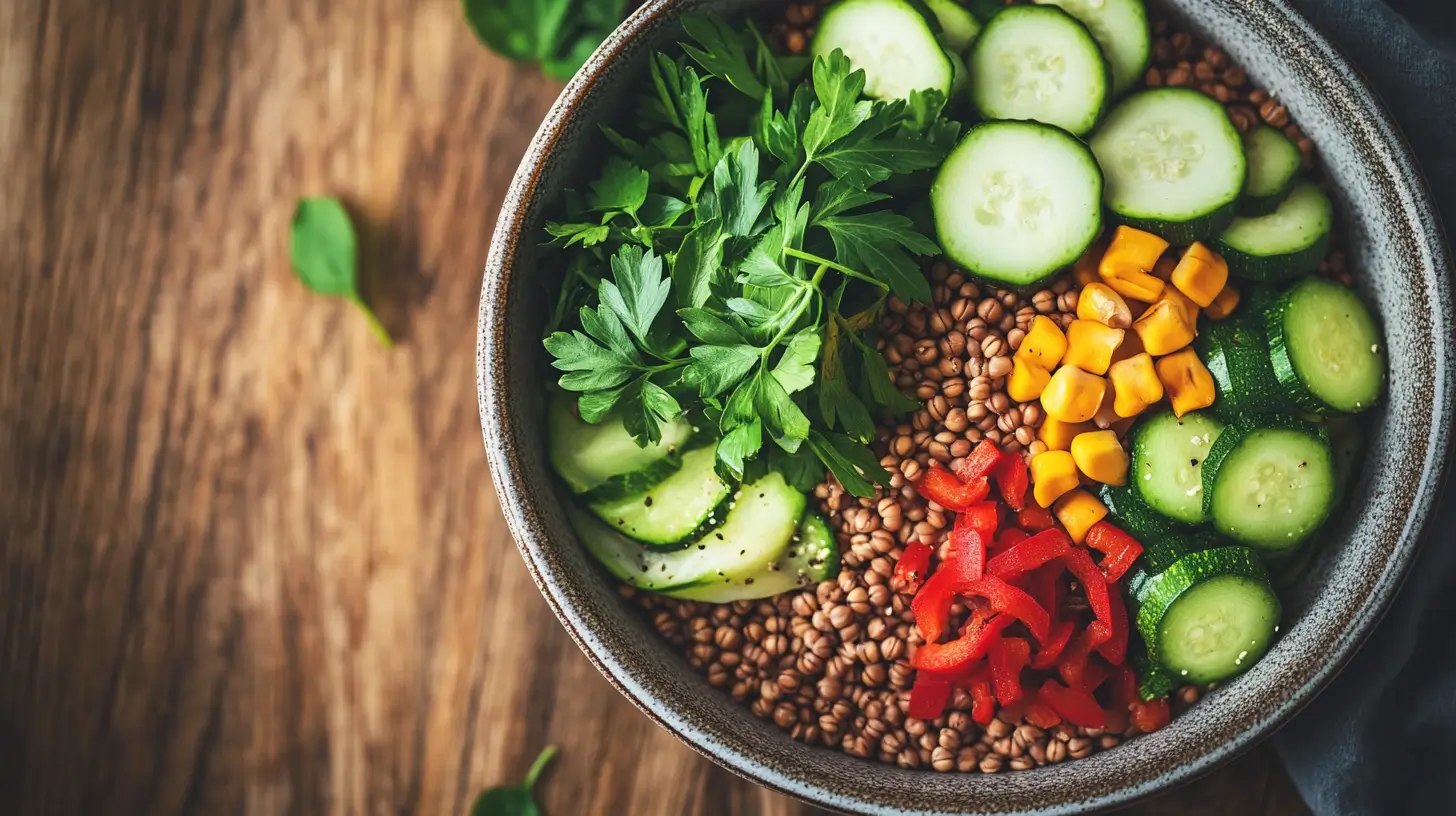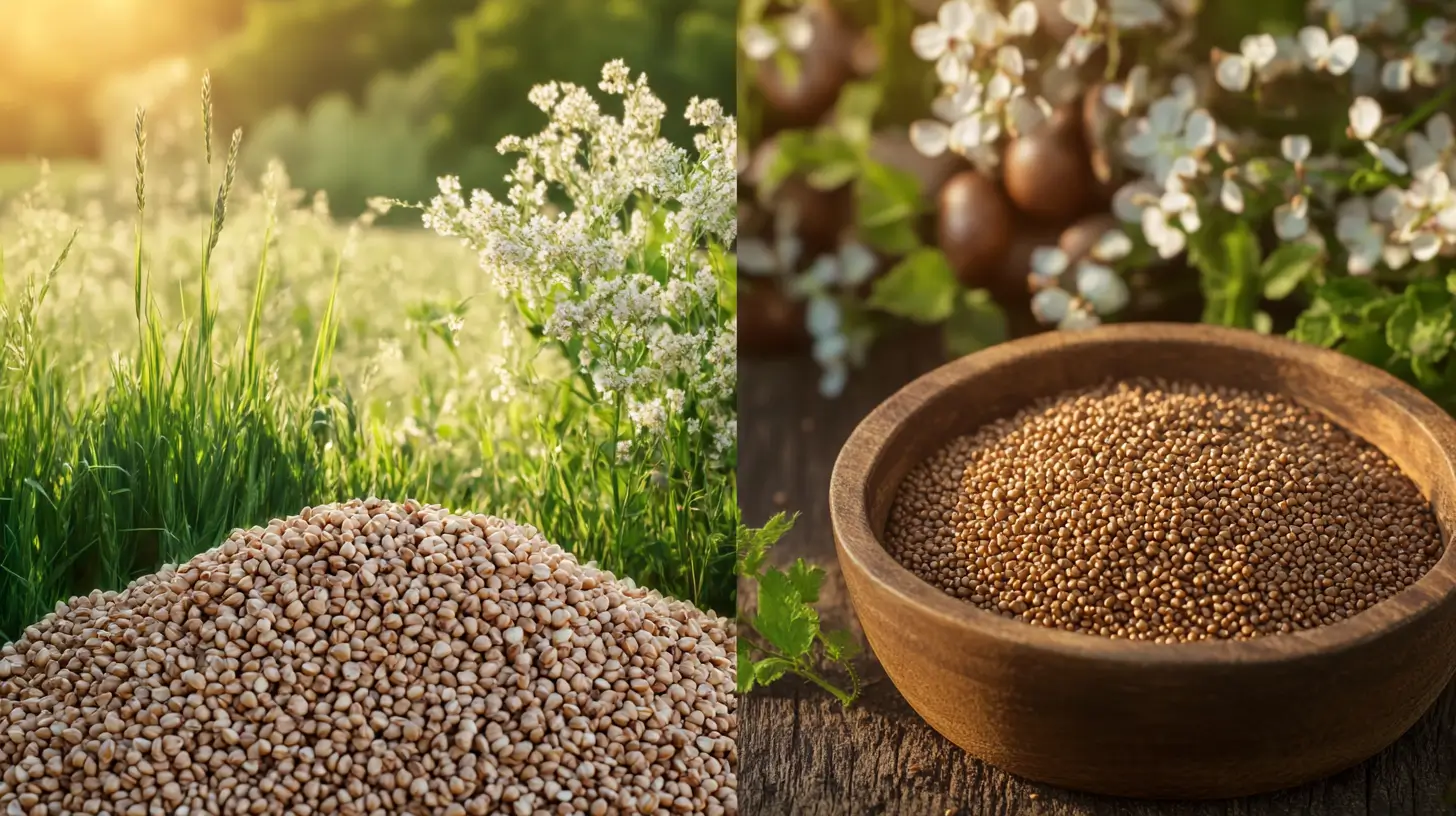How to Make Kasha Low Carb is a question many health-conscious eaters are asking, especially those following low-carb or ketogenic diets. Kasha, a versatile dish with deep-rooted cultural significance, has gained popularity for its hearty and satisfying qualities. However, its traditionally high carbohydrate content can pose challenges. In this guide, we’ll explore how to reduce the carbs in kasha, highlight its nutritional benefits, and offer keto-friendly alternatives to enjoy this classic dish guilt-free.
What is Kasha and Is It Low Carb?
How to Make Kasha Low Carb starts with understanding what kasha actually is. Kasha refers to a cooked grain dish commonly made with buckwheat groats, a staple in Eastern European cuisine. Known for its earthy flavor and nutty undertones, kasha is often served as a side dish or incorporated into soups, salads, and casseroles. While traditionally prepared with buckwheat, modern adaptations allow for ingredient substitutions, making it a versatile choice for various dietary preferences.
To successfully make kasha low in carbs, it’s crucial to examine its traditional components and explore low-carb alternatives that preserve both flavor and texture.
Nutritional Profile of Traditional Kasha
Carbohydrates in Kasha
How to Make Kasha Low Carb begins by understanding its traditional carbohydrate content. Made with buckwheat groats, classic kasha is naturally gluten-free but high in carbs. One cup of cooked buckwheat contains around 33 grams of net carbs, which can be limiting for those following low-carb or ketogenic diets. To reduce these carbs, you’ll need creative ingredient swaps that still honor the spirit of the dish.
Nutrients in Kasha Beyond Carbohydrates
Buckwheat offers a rich source of fiber, magnesium, and antioxidants, contributing to improved digestion and overall health. It is also a complete protein, containing all nine essential amino acids. However, these benefits can be maintained with thoughtful ingredient swaps to make kasha low carb.
Benefits of Making Kasha Low Carb
How to Make Kasha Low Carb isn’t just about reducing carbs — it also comes with several key benefits:
- Supports Ketogenic Diet Goals: Using low-carb substitutes keeps you in ketosis while still enjoying hearty meals.
- Maintains Nutritional Value: Smart swaps like flaxseed meal and almond flour provide essential nutrients similar to traditional kasha.
- Promotes Weight Management: Reducing carbohydrate intake can help regulate blood sugar levels and support weight loss.
- Boosts Dietary Variety: Incorporating low-carb kasha into your diet introduces diverse flavors and textures.
By modifying kasha to fit a low-carb lifestyle, you can savor this nostalgic comfort food without sacrificing your health goals.
Keto-Friendly Alternatives
When learning how to make kasha low carb, selecting keto-friendly substitutes is essential. These ingredients lower the carbohydrate content while preserving the dish’s warm, hearty nature.
Here are some of the best low-carb alternatives for kasha:
- Flaxseed Meal: This ingredient offers a similar texture to buckwheat and is packed with fiber and omega-3 fatty acids. When cooked, it provides a slightly chewy consistency that mimics traditional kasha.
- Cauliflower Rice: A versatile, low-carb substitute, cauliflower rice absorbs flavors well and provides a tender texture. It’s also rich in nutrients like vitamin C and antioxidants.
- Almond Flour: Perfect for adding creaminess, almond flour is low in carbs and nutrient-dense, making it an excellent choice for keto-friendly kasha.
By experimenting with these alternatives, you’ll discover how to make kasha low carb in a way that’s both nourishing and delicious.
Choosing the Right Ingredients
Knowing how to make kasha low carb starts with selecting the right substitutes that mimic the texture and flavor of traditional buckwheat while keeping carbs in check.
Flaxseed Meal as a Substitute
Flaxseed meal is an excellent low-carb alternative to buckwheat groats. Here’s why it works:
- Low in Carbs: One tablespoon contains just 2 grams of carbs, with most being fiber.
- High in Healthy Fats: The omega-3 fatty acids in flaxseeds promote heart health.
- Rich Texture: When cooked, flaxseed meal achieves a slightly chewy consistency, akin to traditional kasha.
Preparation Tips:
- Combine flaxseed meal with hot water or broth to replicate the porridge-like texture of kasha.
- Add spices like garlic powder or paprika for an enhanced flavor profile.
Cauliflower Rice as a Base
Another smart approach when learning how to make kasha low carb is to use cauliflower rice. It’s mild in flavor, quick to cook, and absorbs seasonings effortlessly.
Why Choose Cauliflower Rice:
- Minimal Carbs: One cup contains only 3 grams of net carbs.
- Nutrient-Packed: High in vitamin C and antioxidants, cauliflower supports immune health.
- Quick to Cook: Its short cooking time makes it convenient for busy lifestyles.
How to Use:
- Sauté cauliflower rice in olive oil with onions and garlic for a savory base.
- Add herbs like parsley or dill to replicate traditional Eastern European flavors.
Almond Flour for Texture
Incorporating almond flour into your low-carb kasha recipe can add creaminess and a subtle nutty flavor.
Benefits:
- Low in Carbs: With only 2 grams of net carbs per 2 tablespoons, almond flour keeps your dish keto-friendly.
- Protein-Rich: Almonds contribute to your daily protein intake.
- Versatile: Almond flour can thicken the dish while complementing other low-carb ingredients.
Usage Tips:
- Mix almond flour with flaxseed meal or cauliflower rice for added texture.
- Incorporate a splash of unsweetened almond milk for creaminess.
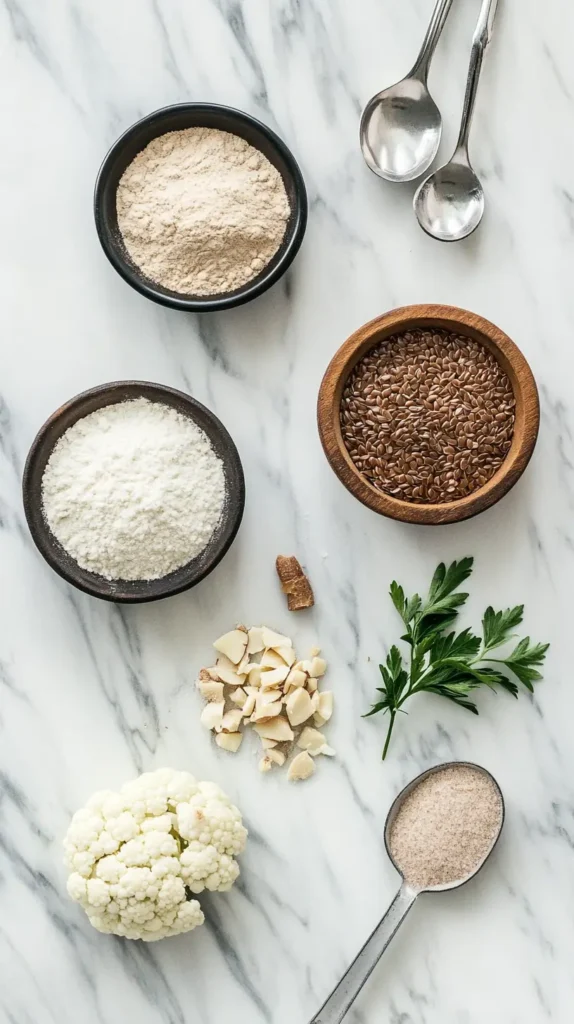
Step-by-Step Guide to Making Low-Carb Kasha
Gathering Ingredients for Low-Carb Kasha
Before diving into how to make kasha low carb, gather all the essential ingredients to streamline the process:
- Low-Carb Base: Flaxseed meal, cauliflower rice, or almond flour.
- Liquid: Vegetable or chicken broth for flavor; water works as well.
- Seasonings: Salt, pepper, garlic powder, onion powder, and paprika.
- Optional Add-Ins: Chopped herbs (parsley or dill), minced garlic, and diced onions.
- Toppings: Keto-friendly options like sour cream, avocado slices, or shredded cheese.
Having your ingredients measured and ready to use simplifies preparation and ensures a smooth cooking experience.
Preparation Steps to Make Kasha Low Carb
If you’re wondering exactly how to make kasha low carb, follow this simple process for the best results:
- Prepare Your Base:
- For flaxseed meal, mix with hot broth or water until thickened.
- For cauliflower rice, sauté in olive oil until tender.
- For almond flour, combine with hot broth for a creamy consistency.
- Cook Add-Ins:
- Sauté onions and garlic in olive oil or butter until golden brown.
- Add herbs and spices for a flavorful base.
- Combine Ingredients:
- Stir your chosen base with the sautéed mix, ensuring even distribution.
- Simmer on low heat, allowing flavors to meld.
- Taste and Adjust:
- Add salt, pepper, or additional seasonings to taste.
This step-by-step approach ensures you master how to make kasha low carb without sacrificing the comfort and warmth of the traditional dish.
Seasoning Your Kasha
Seasoning is the key to elevating the flavor of low-carb kasha. Using the right combination of spices and herbs transforms the dish into a mouthwatering experience.
- Classic Spices: Garlic powder, onion powder, paprika, and black pepper.
- Herbs: Parsley, dill, or chives for freshness.
- Umami Boosters: Soy sauce, nutritional yeast, or a splash of Worcestershire sauce.
Sprinkle in seasonings gradually and taste as you go. One of the secrets to how to make kasha low carb successfully is layering flavor from start to finish.
Serving Suggestions for Low-Carb Kasha
Mastering how to make kasha low carb doesn’t stop at cooking — it’s also about how you serve it. Thoughtful toppings and pairings can elevate both the flavor and nutritional profile of your dish.
Low-Carb Toppings
Adding toppings to low-carb kasha enhances its taste and texture while keeping it keto-friendly. Consider these options:
- Creamy Additions: Sour cream, Greek yogurt, or cream cheese.
- Healthy Fats: Sliced avocado, chopped nuts, or a drizzle of olive oil.
- Protein Boosters: Grilled chicken, smoked salmon, or fried eggs.
- Vegetables: Roasted mushrooms, sautéed spinach, or diced bell peppers.
Toppings not only boost flavor but also let you personalize your version of how to make kasha low carb to fit your dietary needs and taste preferences.
Complementary Dishes
Pairing your low-carb kasha with the right sides creates a balanced and satisfying meal. Here are a few ideas:
- Salads: A fresh cucumber or arugula salad adds a crisp contrast.
- Soups: Pair with a low-carb vegetable soup or bone broth for a comforting combination.
- Proteins: Grilled fish, roasted chicken, or seared tofu make excellent companions.
- Low-Carb Bread: Almond flour or coconut flour-based bread for a hearty meal.
These combinations provide a full dining experience while showcasing the versatility of learning how to make kasha low carb at home.
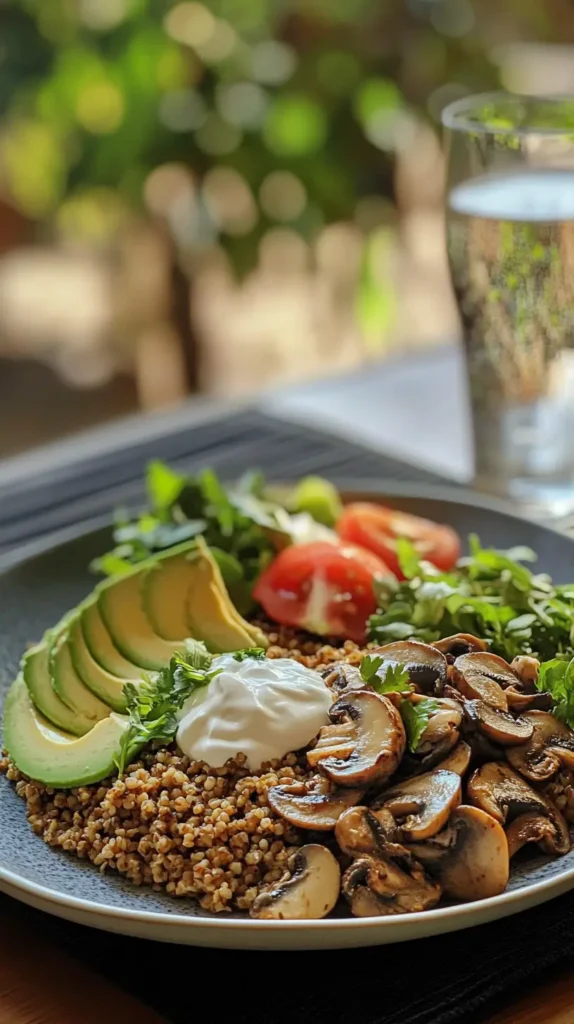
FAQs About Low-Carb Kasha
Is Kasha Low in Carbs?
No, traditional kasha is not naturally low in carbohydrates. Typically made from buckwheat groats, one cup of cooked kasha contains about 33 grams of net carbs, which can be too high for those following strict low-carb or ketogenic diets.
However, if you’re wondering how to make kasha low carb, the solution lies in smart substitutions. Replacing buckwheat with low-carb alternatives like flaxseed meal, cauliflower rice, or almond flour can significantly reduce the carb content while preserving the dish’s hearty texture and flavor.
These ingredients make it possible to enjoy a comforting bowl of kasha without compromising your dietary goals. Pairing your low-carb version with keto-friendly toppings and sides further ensures it fits perfectly into your lifestyle, all while keeping the essence of traditional kasha intact.
Can You Eat Buckwheat on a Low-Carb Diet?
Buckwheat is not ideal for strict low-carb diets due to its high carbohydrate content. A single cup of cooked buckwheat contains around 33 grams of net carbs, which can quickly exceed the daily carb limit for low-carb or ketogenic eating plans. However, if you’re following a more flexible, moderate low-carb diet, small portions of buckwheat can be incorporated in a controlled manner, especially when balanced with high-fat and high-protein foods.
Alternatively, you can replace buckwheat with low-carb ingredients like flaxseed meal or cauliflower rice to create dishes reminiscent of traditional buckwheat recipes without exceeding your carb goals. These alternatives provide a similar texture and can be seasoned or prepared to mimic the flavors of buckwheat, making them excellent substitutes for maintaining a low-carb lifestyle.
How to Make Buckwheat for Weight Loss?
To make buckwheat for weight loss, focus on portion control and preparation methods that enhance its nutritional profile. Start by cooking buckwheat groats in water or low-sodium vegetable broth to avoid added fats or calories. Incorporate vegetables like spinach, bell peppers, or zucchini to increase volume and fiber, helping you feel full with fewer calories. Avoid adding high-calorie ingredients such as butter or cream-based sauces; instead, use spices like turmeric, paprika, or black pepper for flavor.
Pair buckwheat with lean protein sources like grilled chicken, tofu, or fish to create a balanced meal that supports weight loss. If you’re aiming to reduce carb intake while losing weight, consider mixing a small amount of buckwheat with a low-carb alternative like cauliflower rice to enjoy its nutty flavor without consuming excess carbohydrates.
What is the Difference Between Buckwheat and Kasha?
The terms buckwheat and kasha are often used interchangeably, but they refer to different forms of the same plant. Buckwheat is the raw, whole seed of the buckwheat plant and is commonly used in groats, flour, or pancake mixes. It’s naturally gluten-free and rich in nutrients like fiber, antioxidants, and protein.
Kasha, on the other hand, specifically refers to roasted buckwheat groats. The roasting process enhances their nutty flavor and gives them a deeper, more distinct aroma and texture. Kasha is traditionally cooked as a porridge or hearty side dish, especially in Eastern European cuisine.
If you’re exploring how to make kasha low carb, understanding this difference is key. Since roasted buckwheat is high in carbs, it can be replaced with low-carb ingredients like flaxseed meal or cauliflower rice. These alternatives replicate kasha’s texture and warmth while significantly reducing the carbohydrate content—making them perfect for low-carb and ketogenic lifestyles.
Conclusion
Learning how to make kasha low carb is a rewarding way to enjoy a beloved traditional dish without the excess carbs. With the right ingredient substitutions, simple preparation steps, and flavorful toppings, you can transform classic kasha into a low-carb, keto-friendly comfort food that satisfies both taste and nutrition goals.
Whether you’re cooking for yourself or sharing it with family and friends, low-carb kasha delivers hearty satisfaction and endless versatility. With a bit of creativity and thoughtful planning, this dish can easily become a staple in your healthy, low-carb recipe collection.

